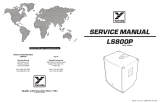Page is loading ...

Creme Fluff
Fat, open, rich IC-based fuzz
Contents of this document are ©2015 Pedal Parts Ltd.
No reproduction permitted without the express written
permission of Pedal Parts Ltd. All rights reserved.

Schematic
BOM
R1 33K
R2 10K
R3 1M
R4 1K5
R5 2K2
R6 100K
R7 1M
R8 10K
R9 20K
R10 2K2
R11 47K
R12 CLR (2K2)
R13 33K
R14 33K
C1 1u elec
C2 100p
C3 10u elec
C4 10u elec*
C5 390p
C6 1u elec
C7 150n
C8 4n7
C9 10u elec
C10 100u elec
D1-4 3mm red LED
D5 1N4001
IC1 4558
FUZZ 100KB
TONE 10KB
VOL 100KB
*C4 has been reversed on the PCB. Place this with the + leg in the round pad.

The power and signal pads on the PCB conform to the FuzzDog
Direct Connection format, so can be paired with the appropriate
daughterboard for quick and easy offboard wiring.
Snap the small metal tag off the pots so they can be mounted
flush in the box.
Pots mount on the back side of the board. You can use vertical-mount
pots or just wire up ‘normal’ ones.
The striped leg (cathode) of the 1N4001 diode goes into the square pad. Long legs (+) of
the LEDs go into the round pads.
The long leg (anode) of the electrolytic capacitors go into the square pads.
Don’t forget to reverse C4!
Solder the pots last, otherwise you
can’t get at the pads to solder other
components or the signal/power
wires. It helps to place the pots in the
holes on the top of the enclosure to
make sure you get everything nicely
lined up and at the same vertical
level.
1 2 3
PCB Layout ©2014 Pedal Parts Ltd.

Test the board!
UNDER NO CIRCUMSTANCES will troubleshooting help
be offered if you have skipped this stage. No exceptions.
Once you’ve finished the circuit it makes sense to test is before
starting on the switch and LED wiring. It’ll cut down
troubleshooting time in the long run. If the circuit works at this
stage, but it doesn’t once you wire up the switch - guess what?
You’ve probably made a mistake with the switch.
Solder some nice, long lengths of wire to the board connections for
9V, GND, IN and OUT. Connect IN and OUT to the jacks as shown.
Connect all the GNDs together (twist them up and add a small
amount of solder to tack it). Connect the battery + lead to the 9V
wire, same method. Plug in. Go!
If it works, crack on and do your switch wiring. If not... aw man.
At least you know the problem is with the circuit. Find out why, get
it working, THEN worry about the switch etc.
UO
YRET
T
A
AT
B
NI
TU
GND
9V
IN
S
T
UDING WIRED PO
INCL
cuit boa
w cir
e, ne
our nic
Y
o
NI
OUT
!!!!
d
ar
TUO

(if using a daughterboard please refer to the relevant document)
Wire it up - with battery
This circuit is standard, Negative GND. Your power supply should be
Tip Negative / Sleeve Positive. That’s the same as your standard pedals
(Boss etc), and you can safely daisy-chain your supply to this pedal.
The BOARD GND connections don’t all have to connect to one point.
They can be daisy-chained around the circuit, using larger connection
points (such as jack socket lugs) for multiple connections. As long as
they all connect together in some way.
PedalParts.co.uk
L
E
D
BOARD
OUT
BOARD
9V
BOARD
GND
BOARD
GND
BOARD
GND
BOARD
INPUT
BATTERY
+
IN
OUT
L
E
D
BOARD
GND
BOARD
LED+
+
/












